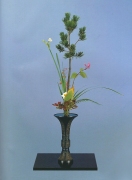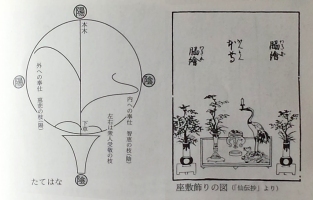Tatehana, Deutsch
 Liebe Schülerinnen und Schüler,
Liebe Schülerinnen und Schüler,
geschätzte Freundinnen und Freunde des Ikenobo-Ikebana
Gern lasse ich euch unten einen kurzen Text zum Tatehana zukommen.
Ikebana ist eine Tradition des Lehrens und Lernens, in der nicht einfach aus Büchern gelernt und Wissen vermittelt wird, sondern Schülerinnen und Schüler von ihrer oder ihrem Sensei in eine Kunst eingeweiht werden. Als eure langjährige Sensei ist es mir eine grosse Freude, mein Ikebana-Wissen mit euch zu teilen und euch eine kleine Anleitung und einige Gedanken zum Tatehana zu geben.
Was bedeutet «Tatehana»?
«Tatehana» bedeutet «aufrechte Form» (tateru = stehen, hana = Blumen).
Was ist Tatehana?
Im Tatehana spiegelt sich die geistige Welt des Buddhismus. Wir können Tatehana aber auch verstehen, ohne Buddhisten zu sein. Tatehana ist die frühe Kunst der Blumenopfergabe, die sich auch in anderen Kulturen findet. In Japan wurde Tatehana für den Hausaltar mit Mitsugusoku verwendet.
 |
Bild „Tatehana, Schema“ rechts: 1. Tatehana 2. Rauchopfergabe 3. Kerzenopfergabe |
Welches sind die Teile von Tatehana?
Die Tatehana-Sphäre besteht aus zwei Aspekten, die sich ergänzen, nämlich A. «Yo» und B. «In», und drei Teilen, nämlich 1. «Motoki», 2. «Shita kusa» und 3. der «Erde».
A. «Yo»
Die linke Hälfte der Sphäre, die Sonnenseite oder «Yo», steht für unsere äussere Pflicht, das heisst für das Dienen im praktischen und im geistigen Sinn. Wer Herrin oder Herr sein will, muss vor allem dienen. Gemäss der buddhistischen Lehre heisst dienen: Wir begegnen allen Mitmenschen mit Nächstenliebe, Respekt und Wohltätigkeit. Dienen heisst aber auch Dankbar-sein. Für die Schöpfung, für die Natur sind wir dankbar (Jihi). Dieser Dank findet seinen Ausdruck auch im Gebet, im Staunen vor der Macht und Schönheit der Natur.
B. «In»
Die rechte Hälfte der Sphäre, die Schattenseite oder «In», steht für unsere innere Pflicht. Auch die innere Pflicht ist ein Gebet: Wir bitten um Einsicht, Weisheit, Klugheit, Verstand und Empfindsamkeit. Letztere ist ganz wichtig im Ikebana: Nur als empfindsame, sensible Menschen sind wir offen für die feine Schönheit der Natur.
1. «Motoki»
Der obere Teil der Sphäre, japanisch «motoki», verweist auf den Ursprung der Welt, auf Raum und Zeit und auf und den Kosmos insgesamt. «Motoki» ist die Sphäre des Oben «Yo», der Macht und der Pracht.
2. «Shita kusa»
In der Sphäre unten, japanisch «shita kusa» manifestiert sich die Öffnung des Lebens, die Geburt, das In-die Welt-Kommen und das Wachsen. Wachsen und Gedeihen kommen immer von unten «In», aus einer demütigen Haltung.
3. «Erde»
Worauf gründen sich Oben und Unten, Macht und Demut? Sie haben einen gemeinsamen Boden. Sie kommen aus dem Dunkel und erheben sich ins Licht. Aber sie schweben nicht, sondern sie sind fest verwurzelt, haben einen kräftigen Stamm und verzweigen sich in eine geordnete Vielfalt.
Ich wünsche euch allen, liebe Schülerinnen und Schüler, geschätzte Freundinnen und Freunde des Ikenobo-Ikebana, persönlich alles Gute und viel Freude beim Ikebana.
Herzliche Grüsse
Shunzuen Suzue Rother-Nakaya
Tatehana, English
 Dear students,
Dear students,
Dear friends of Ikenobo Ikebana
I am happy to send you a short text, below, about Tatehana.
Ikebana is a tradition of teaching and learning, in which the learning is not simply acquired from books and thereby knowledge is imparted, but pupils are initiated into an Art form by their Sensei. As your longtime Sensei, it is therefore a great pleasure for me to share my Ikebana knowledge with you and to give you a little guide and some thoughts about Tatehana.
Firstly, what does the word «Tatehana» mean?
«Tatehana» means „upright form“, which derives from two Japanese words – „tateru“, to stand and „hana“, which translates as flowers
But what, in reality, is Tatehana?
The spiritual world of Buddhism is reflected in a Tatehana arrangement. However, we can also understand Tatehana without being Buddhists. Tatehana is the early Japanese art of flower offering, which is a tradition also found in other cultures. In Japan, it was used for the house altar together with Mitsugusoku – see Picture „Tatehana, Scheme“ on the right. This shows a Tatehana arrangement with accompanying incense burner and candlestick in the form of a standing Crane. The incense burner produces smoke to carry earthly prayers to heaven and the candle is an offering of light.
 |
Picture „Tateneana, Scheme“ right: 1. Tatehana 2. Incense burner 3. Candlestick |
What are the composite parts of a Tatehana arrangement?
The Tatehana composition consists of two sides that are complementary – namely «Yo» and «In», and three succeeding levels – namely «Motoki», «Shita kusa» and «Earth».
«Yo»
The left-hand side of the composition is the sunny side. It symbolises our external duty, that is our need for serving in a practical and spiritual sense. Whoever wants to be in control of others must, above all, serve. According to the Buddhist teaching, „service“ means to treat all fellow human beings with charity, respect and kindness. But to serve also means to be grateful for our life. We are grateful for the whole of Creation and for Nature. This gratitude can be expressed through prayer and also by our simple amazement at the power and beauty of Nature.
«Am»
Is the right-hand side of the arrangement. This is the shadow side or «In», and it stands for our inner duty. Inner duty is also a prayer, where we ask for insight, wisdom, prudence, understanding and sensitivity. This latter quality is especially important in Ikebana because only as sensitive people are we open to the fine beauty of Nature.
Turning now to the three levels in the arrangement.
Firstly, «Motoki»
This is the upper part of the Tatehana sphere. The Japanese word «motoki» refers to the origin of the world – to space and time – and to the cosmos as a whole. Hence, «Motoki» is the realm of heaven; of power and splendour.
The level below this is «Shita kusa»
The Japanese word «shita kusa» means the start of life, the birth, or entry into the world where growth begins. Thus, growth and prosperity always come from below and from «In», which is a humble attitude.
The third and lowest level is «Earth»
What are the levels above, or power and humility, ultimately based on? They do in fact have common ground. They are initiated in the dark and rise into the light – but they do not float, they are firmly rooted in the earth, with a strong trunk that rises and branches out in an orderly fashion.
I send you all, dear students, dear friends of Ikenobo Ikebana, my personal good wishes for the best in your life and lots of fun with Ikebana.
Take care and best regards,
Shunzuen Suzue Rother-Nakaya